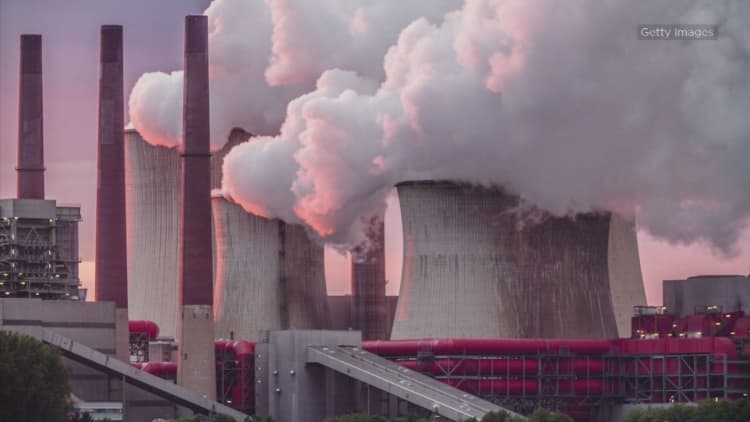
The Trump administration has a plan to keep coal and nuclear power plants running, but analysts are skeptical it will do enough to prevent more of the facilities from closing down.
Energy Secretary Rick Perry has proposed subsidizing coal-fired plants and nuclear power stations to compensate them for the reliable energy they provide to the nation's grid. The Federal Energy Regulatory Commission, which Perry directed to study the issue, is scheduled to deliver a decision on the proposed rule on Monday.
On Thursday, incoming FERC Chairman Kevin McIntyre asked Perry for a 30-day extension.
Ahead of that decision, energy analysts say the plan — along with a related proposal from a regional energy organization — would likely boost cash flow for some embattled power producers. But those benefits might not be big enough to dissuade them from shuttering noncompetitive plants, even as the plan raises electric power costs for ratepayers.
In vowing to revive the coal industry and stop the decline of nuclear energy, President Donald Trump is fighting against a tide of coal and nuclear power plant closures. That trend is being driven by growing competition from cheap, cleaner-burning natural gas and renewable energy, as well as weak power prices and environmental regulations.
Perry's rule would apply in several regional wholesale energy markets established during a wave of deregulation in the early 2000s. Companies that generate electric power and sell it into these markets have struggled to find a winning business model in the face of seismic shifts in the utility space.
Some say Perry's plan is too little, too late. Many publicly traded utilities have for years been shedding coal and nuclear power plants, says Travis Miller, director of utilities research at Morningstar.
"If we rewind 10 years, this would be a major issue for many of the utilities," he said. "Now, it's almost irrelevant for the publicly traded utilities. But it's very relevant for the market."
The plan would raise electric power prices by hundreds of millions or billions of dollars per year, three separate studies found. The range is wide because there are few details about the plan.
Asked by Democrats about rising costs during a House hearing, Perry said, "I think you take costs into account, but what's the cost of freedom? What's the cost to keep America free? I'm not sure I want to leave that up to the free market."
In Perry's view, ratepayers would be rewarded with a more resilient power grid. That's because coal and nuclear plants, which keep fuel stockpiles on site, would ostensibly remain online to back up natural gas facilities and wind and solar power.
Over the next decade, power costs could rise between $18 billion and $288 billion under the Perry plan, according to a study by PJM Interconnection, which runs the transmission grid and energy market in all or part of 13 eastern states and Washington D.C. Analysts say Perry's rule would mostly affect the PJM region, which includes Pennsylvania, New Jersey and Maryland.
Regional Transmission Organizations, source: FERC
PJM put forward a separate plan last month to change the way electricity is priced in its wholesale market. It would allow inflexible power plants, which include coal and nuclear facilities, to help set the price of energy, which is forecast to boost revenues for all power generators.
Unlike the Perry plan, PJM is not explicitly trying to subsidize coal and nuclear plants. Instead, it aims to better reflect the true cost of delivering power by acknowledging the role that coal and nuclear plants play in supplying the grid and compensating them for it.
That plan would provide some benefits to power plant operators, but it would not be a game-changer, said David Cherney, an energy industry adviser at PA Consulting.
"It's helpful at the margins, but if you're talking about making long-term investment decisions about assets that can have a 40, 50, 60, 70-year useful life, that is not going to change that calculation at the end of the day," he told CNBC.
A more direct way to keep certain types of plants on the grid is through state-level support, said Matt Mooren, also an adviser at PA Consulting. Illinois and New York have recently approved zero-emissions credits to save clean-burning nuclear plants. But Mooren notes this strategy faces opposition because it undermines the open market competition the deregulated markets are supposed to promote.
Under the PJM plan, utilities could see their cash flow increase by tens or even hundreds of millions of dollars, according to Moody's Investor Services. Exelon, which operates nuclear power plants in the region, would see cash flow increase by $500 million. Utilities including Talen Energy, Dynegy and FirstEnergy Solutions would increase cash flow by about $150 million.
But there's a problem. Those projections depend on electric power prices rising by $3.50 per megawatt-hour, as modeled by PJM. If prices rise that much, Moody's believes many distressed plants could stay open, but it's not confident the proposal will boost prices to that level.
"It's a craps shoot," said Toby Shea, senior credit officer at Moody's. "The spot market is very volatile. There are a lot of factors. At the end of the day, whether you're going to get the $3.50 is hard to say."
In the long run, efforts to keep noncompetitive coal and nuclear plants alive could simply delay their inevitable retirement, he said.
"The market corrects itself by driving down the prices to the point where someone has to leave," he said. "This kind of throws a wrench into the mechanism."


